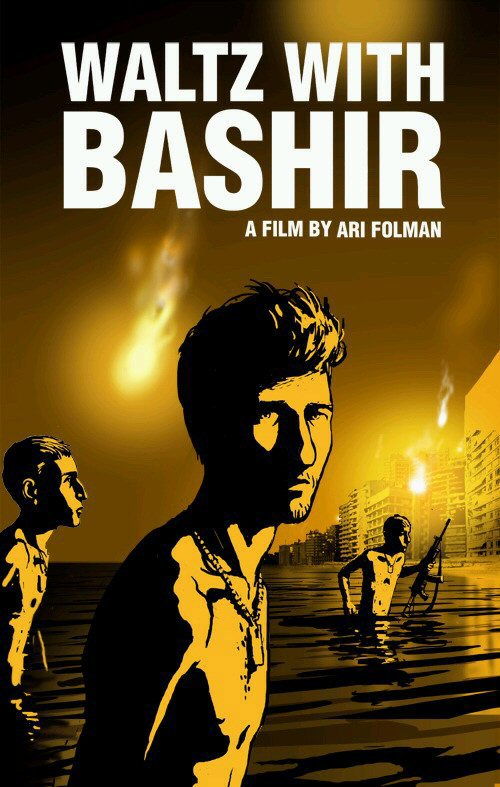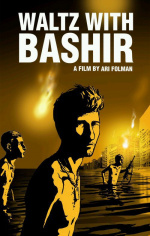Just In!
Don't Let's Go to the Dogs Tonight director-star Embeth Davidtz and executive producer Trevor Noah will participate in a Q&A following the July 10 early access screening at the Royal.
Waltz with Bashir
A “powerhouse film.”
Waltz with Bashir
WALTZ WITH BASHIR was named Best Picture of 2008 by the National Society of Film Critics.
An Oscar nominee for Best Foreign Language Film.
One night at a bar, an old friend tells director Ari about a recurring nightmare in which he is chased by 26 vicious dogs. Every night, the same number of beasts. The two men conclude that there's a connection to their Israeli Army mission in the first Lebanon War of the early eighties. Ari is surprised that he can't remember a thing anymore about that period of his life. Intrigued by this riddle, he decides to meet and interview old friends and comrades around the world. He needs to discover the truth about that time and about himself. As Ari delves deeper and deeper into the mystery, his memory begins to creep up in surreal images.
“An extraordinary film - a military sortie into the past in which both we and Folman are embedded like traumatised reporters.” (Peter Bradshaw, Guardian [U.K.])
A “powerhouse film, “Waltz With Bashir,” an animated documentary from Israel about the 1982 massacre at the Sabra and Shatila Palestinian refugee camps in Lebanon. Written and directed by Ari Folman, who has made some half-dozen live-action documentaries, and animated by the Bridgit Folman Film Gang, the movie is a soldiers’ story by one of their own: the haunted young man at its center is Mr. Folman himself.
“He plunges us right into his nightmare with a harrowing vision of low-down and dark dogs running at the camera, teeth bared and eyes glowing bilious orange-yellow. The dogs run and they run, gathering in number as they cut a swath through everything and everyone — men, women, children — in their path.
People scatter like pebbles, and a ribbon of slobber lashes the camera lens. Finally, the dogs stop under a window where a man several stories up from the street warily looks down at the snapping, barking, growling menace below. Cut to a bar, where a man, Ari (Mr. Folman), asks his friend Boaz, the man who has dreamed himself into that phantasmagoric scene, what happens next. “I wake up,” Boaz says.
“Like Boaz, who is haunted by the war in Lebanon (or rather his absence of its memories), Ari is plagued by a past he can’t recall. And so he sets out to uncover history, to sift through the memories of other Israeli soldiers — all but two of the nine testimonials are firsthand accounts — and to make sense of the one image he does retain, that of three young soldiers rising naked out of the sea and somnolently drifting into the Beirut battlefield. As in “Maus,” Art Spiegelman’s two-volume graphic novel about the Holocaust, the animation in “Waltz With Bashir” initially works as something of a distancing device, giving you the space — intellectual, emotional — to process the story and its accumulating horrors.
“Mr. Folman isn’t a revisionist: he points fingers at the followers of Bashir Gemayel, the charismatic Christian militia leader and Lebanon’s president-elect whose assassination preceded the mass murder at the camps, and saves hard words for Ariel Sharon, then the Israeli defense minister. Mr. Folman also doesn’t blink when it comes to what young soldiers do in wartime: at the sniper who lethally picks a man off a donkey, at the tank that crushes flowers and then cars under its wheels, taking down men drinking coffee and buildings alike. First pop songs fill the air and then yellow flares.
“Brought to vital, plausible life in a combination of Flash, classic and 3-D animation, the characters look as if they stepped right out of a graphic novel. Their faces and bodies, for instance, are outlined in black, but their faces are so ductile and expressive that I was surprised that they hadn’t been rotoscoped (the animation technique in which live-action movement is traced over). The fluidity of the figures accentuates the air of surreality — one soldier compares war to an acid trip — which deepens as the story reaches its terrible end. That finale, which finds the animation violently giving way to live-action documentary footage, is stunning, at once a furious act of conscience and a lament.” (Manohla Dargis, New York Times)
An Oscar nominee for Best Foreign Language Film.
One night at a bar, an old friend tells director Ari about a recurring nightmare in which he is chased by 26 vicious dogs. Every night, the same number of beasts. The two men conclude that there's a connection to their Israeli Army mission in the first Lebanon War of the early eighties. Ari is surprised that he can't remember a thing anymore about that period of his life. Intrigued by this riddle, he decides to meet and interview old friends and comrades around the world. He needs to discover the truth about that time and about himself. As Ari delves deeper and deeper into the mystery, his memory begins to creep up in surreal images.
“An extraordinary film - a military sortie into the past in which both we and Folman are embedded like traumatised reporters.” (Peter Bradshaw, Guardian [U.K.])
A “powerhouse film, “Waltz With Bashir,” an animated documentary from Israel about the 1982 massacre at the Sabra and Shatila Palestinian refugee camps in Lebanon. Written and directed by Ari Folman, who has made some half-dozen live-action documentaries, and animated by the Bridgit Folman Film Gang, the movie is a soldiers’ story by one of their own: the haunted young man at its center is Mr. Folman himself.
“He plunges us right into his nightmare with a harrowing vision of low-down and dark dogs running at the camera, teeth bared and eyes glowing bilious orange-yellow. The dogs run and they run, gathering in number as they cut a swath through everything and everyone — men, women, children — in their path.
People scatter like pebbles, and a ribbon of slobber lashes the camera lens. Finally, the dogs stop under a window where a man several stories up from the street warily looks down at the snapping, barking, growling menace below. Cut to a bar, where a man, Ari (Mr. Folman), asks his friend Boaz, the man who has dreamed himself into that phantasmagoric scene, what happens next. “I wake up,” Boaz says.
“Like Boaz, who is haunted by the war in Lebanon (or rather his absence of its memories), Ari is plagued by a past he can’t recall. And so he sets out to uncover history, to sift through the memories of other Israeli soldiers — all but two of the nine testimonials are firsthand accounts — and to make sense of the one image he does retain, that of three young soldiers rising naked out of the sea and somnolently drifting into the Beirut battlefield. As in “Maus,” Art Spiegelman’s two-volume graphic novel about the Holocaust, the animation in “Waltz With Bashir” initially works as something of a distancing device, giving you the space — intellectual, emotional — to process the story and its accumulating horrors.
“Mr. Folman isn’t a revisionist: he points fingers at the followers of Bashir Gemayel, the charismatic Christian militia leader and Lebanon’s president-elect whose assassination preceded the mass murder at the camps, and saves hard words for Ariel Sharon, then the Israeli defense minister. Mr. Folman also doesn’t blink when it comes to what young soldiers do in wartime: at the sniper who lethally picks a man off a donkey, at the tank that crushes flowers and then cars under its wheels, taking down men drinking coffee and buildings alike. First pop songs fill the air and then yellow flares.
“Brought to vital, plausible life in a combination of Flash, classic and 3-D animation, the characters look as if they stepped right out of a graphic novel. Their faces and bodies, for instance, are outlined in black, but their faces are so ductile and expressive that I was surprised that they hadn’t been rotoscoped (the animation technique in which live-action movement is traced over). The fluidity of the figures accentuates the air of surreality — one soldier compares war to an acid trip — which deepens as the story reaches its terrible end. That finale, which finds the animation violently giving way to live-action documentary footage, is stunning, at once a furious act of conscience and a lament.” (Manohla Dargis, New York Times)
Played at
Town Center 5 12.25.08 - 2.26.09
Royal 12.25.08 - 2.12.09
Playhouse 7 1.30.09 - 2.12.09
Monica Film Center 2.13.09 - 3.05.09
Claremont 5 2.27.09 - 3.05.09
Waltz with Bashir Get Tickets
There are currently no showtimes for this film. Please check back soon.

